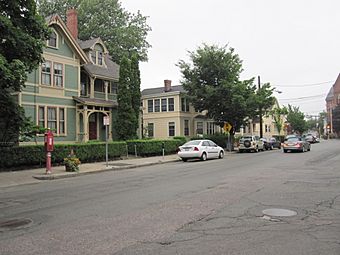Bow Street Historic District facts for kids
Quick facts for kids |
|
|
Bow Street Historic District
|
|
 |
|
| Location | Bow St., Somerville, Massachusetts |
|---|---|
| Area | 3 acres (1.2 ha) |
| Architect | Multiple |
| Architectural style | Late Victorian |
| NRHP reference No. | 76000274 |
| Added to NRHP | March 26, 1976 |
The Bow Street Historic District is a special area in Somerville, Massachusetts. It's part of the Union Square neighborhood. This district is full of old buildings from the 1800s. These buildings include homes and businesses. The area grew a lot during the 19th century. It has been kept in great condition since then. In 1976, the district was added to the National Register of Historic Places. This means it's recognized as an important historical place.
Contents
Discovering Bow Street's Past
The city of Somerville has a long history. Before 1842, it was actually part of Charlestown. The area was first settled way back in 1630. An old path developed early on. This path went around Prospect Hill and a marshy area. It connected Charlestown to a place then called Menotomy. Today, Menotomy is known as Arlington.
How Bow Street Developed
The old path included what is now Washington Street, Bow Street, and Somerville Avenue. The Bow Street part was a curve around a marsh. Later, the marsh was filled in, and the road changed. But before that, Bow Street was an important spot. It became a busy area in the 1800s. Union Square grew into Somerville's main center. It was a hub for businesses and factories. While much of Union Square has been rebuilt, Bow Street still looks like it did in the 1800s.
Historic Buildings to See
The historic district covers most of Bow Street. It includes many interesting old buildings. For example, there's a former police station. It was built around 1875. It has a cool style called Gothic Victorian. You can also see the Prospect Hill Congregational Church. This church was built in 1887. It has a Romanesque Revival style.
Notable Structures in the District
Two other important buildings are the Drouet Block and the Richmond. Both were built in 1898. They were designed by an architect named Aaron Gould. These buildings had shops on the ground floor. Above the shops, they had apartments. They were like early apartment-style hotels. These buildings show how people lived and worked back then.



